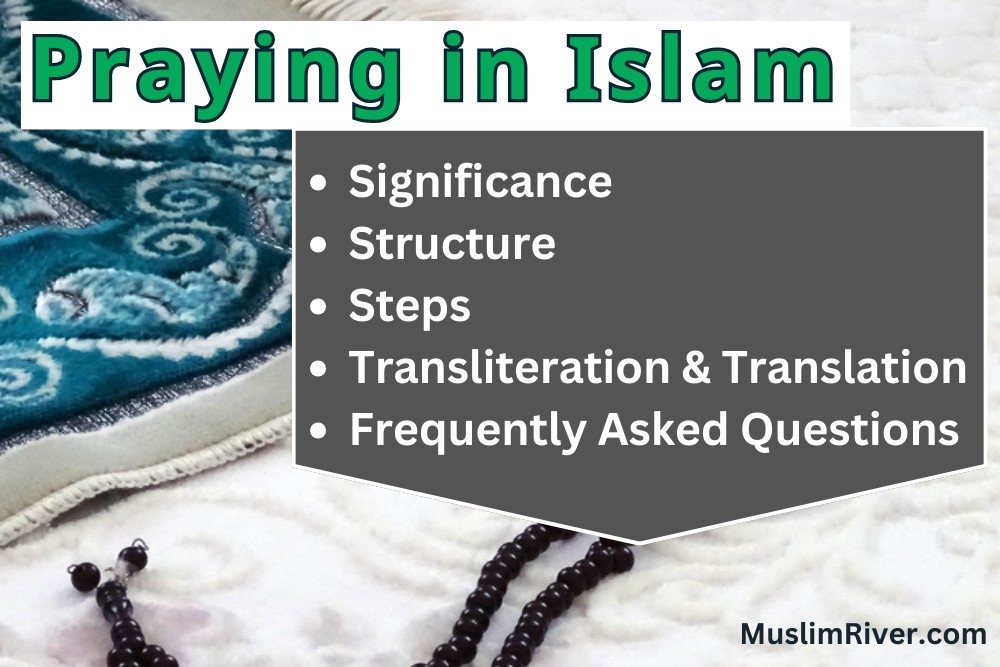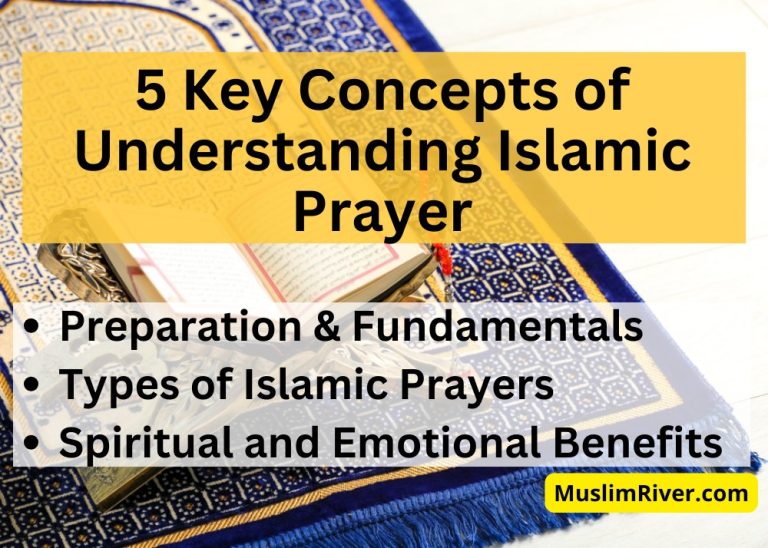Praying in Islam: Step-by-Step Transliteration & Translation Guide
Have you ever felt language barriers keep you from connecting with your prayers?
If Yes, then read our comprehensive guide on the Complete Islamic Prayer with Transliteration & Translation. The guide will help you foster a deeper emotional connection with Allah..
As we explore the Complete Islamic Prayer with Transliteration deeper, it’s essential to grasp the basics that hold it together.

Salah – Pillars of Islamic Prayer and Their Significance
Islamic prayer, known as Salah, is not merely a ritual but a profound expression of faith and a bridge between the believer and their Creator.
Each aspect of Salah—from its timing to the physical and spiritual preparation required—carries deep significance.
The core components that make Islamic prayer a holistic and transformative experience are the significance of Salah, the prescribed times for prayer, the necessity of cleanliness through Wudu, and the importance of the Qibla.
- Significance: Islamic prayer, or Salah, is a pivotal expression of faith and devotion, connecting the believer to their Creator five times a day.
- Times: Prescribed at five specific times throughout the day, each prayer has significance and spiritual benefits.
- Cleanliness: Before standing in prayer, physical purification through Wudu (ablution) is essential, symbolizing spiritual cleanliness and readiness.
- Qibla: Direction matters in Islamic prayer, with all Muslims worldwide facing the holy Kaaba in Mecca as a unified faith community.
Let’s take a closer look at these pillars to understand their importance and how they contribute to the completeness and sanctity of Islamic prayer. Here is a link to our other blog post explaining these concepts in more detail. Link?
Islamic Prayer Structure
Exploring Islamic prayer, or Salah, takes us into a world where devotion meets structure. Let’s break down this spiritual practice into key elements, making it simple and deeply meaningful.
Rak’ah: The Core of Prayer
Rak’ahs are the building blocks of Salah, combining standing, bowing, and prostrating. Each prayer time calls for a different number of Rak’ahs, guiding you through a spiritual rhythm.
Sequences: Flowing with Devotion
Every Rak’ah follows a sequence – starting with “Allahu Akbar,” reciting from the Qur’an, bowing, and prostrating. This flow creates a meditative experience, connecting you deeply with your faith.
Obligatory Prayers: Daily Touchstones
The five daily prayers form the backbone of a Muslim’s day, offering moments to reconnect with Allah regularly. They are Fajr (dawn), Dhuhr (noon), Asr (afternoon), Maghrib (sunset), and Isha (night).
Optional Prayers: Extra Steps for the Soul
Beyond the mandatory prayers, there are optional ones for those looking to deepen their spiritual practice. These include extra prayers before or after the obligatory ones, offering flexibility and additional spiritual benefits.
Islamic Prayer with Transliteration & Translation
Here, we’ll take you step by step through a 4 Rak’ah prayer, one of the most common forms of Salah. Remember, the number of Rak’ahs varies for different prayers; consult our detailed guide [Link to another blog post] for specifics.
Step 1: Takbir
Hand/Body Positioning: Stand upright, raise both hands to your ears, and say the Takbir.
What to say:
Arabic: الله أكبر
Transliteration: Allahu Akbar
Translation: Allah is the Greatest
[Mishkat al-Masabih 658 Book 4, Hadith 90]
Source: Search Results – Search Results – الله أكبر (page 1) – Sunnah.com – Sayings and Teachings of Prophet Muhammad (صلى الله عليه و سلم)
Step 2: Opening Du’a
Start your conversation with Allah by praising Him with an opening supplication, acknowledging His glory and majesty.
What to say:
Arabic: سُبْـحانَكَ اللّهُـمَّ وَبِحَمْـدِكَ وَتَبارَكَ اسْمُـكَ وَتَعـالى جَـدُّكَ وَلا إِلهَ غَيْرُك
Transliteration: Subhānaka Allāhumma wa biḥamdika, wa tabāraka ‘smuka, wa ta’ālā jadduka, wa lā ‘ilāha ghayruk.
Translation: Glory is to You, O Allah, and praise. Blessed is Your Name, and Exalted is Your Majesty. There is none worthy of worship but You.
[Hisn al-Muslim 28]
Source: Hisn al-Muslim 28 – Fortress of the Muslim (Hisn al-Muslim) – حصن المسلم – Sunnah.com – Sayings and Teachings of Prophet Muhammad (صلى الله عليه و سلم)
Step 3: Surat Al-Fatiha
Recite the opening chapter of the Quran, Al-Fatiha, a prayer for guidance, mercy, and salvation.
What to say:
Arabic: ١ ٱلْحَمْدُ لِلَّهِ رَبِّ ٱلْعَـٰلَمِينَ ٱلرَّحْمَـٰنِ ٱلرَّحِيمِ مَـٰلِكِ يَوْمِ ٱلدِّينِ إِيَّاكَ نَعْبُدُ وَإِيَّاكَ نَسْتَعِينُ ٱهْدِنَا ٱلصِّرَٰطَ ٱلْمُسْتَقِيمَ صِرَٰطَ ٱلَّذِينَ أَنْعَمْتَ عَلَيْهِمْ غَيْرِ ٱلْمَغْضُوبِ عَلَيْهِمْ وَلَا ٱلضَّآلِّينَ
Transliteration: Alhamdu lillahi rabbi alAAalameen Arrahmani arraheem Maliki yawmi addeen Iyyaka naAAbudu wa-iyyaka nastaAAeen Ihdina assirata almustaqeem Sirata allatheena anAAamta AAalayhim ghayri almaghdoobi AAalayhim wala addalleen
Translation: In the Name of Allah—the Most Compassionate, Most Merciful. All praise is for Allah—Lord of all worlds, the Most Compassionate, Most Merciful, Master of the Day of Judgment. You ˹alone˺ we worship and You ˹alone˺ we ask for help. Guide us along the Straight Path, the Path of those You have blessed—not those You are displeased with, or those who are astray.
Source: https://quran.com/1?startingVerse=2
Step 4: Recite Another Surah
Brief explanation: Choose any Surah. For this example, we’ll use Al-Ikhlas.
What to say (Al-Ikhlas):
Arabic: قُلْ هُوَ ٱللَّهُ أَحَدٌ ١ ٱللَّهُ ٱلصَّمَدُ لَمْ يَلِدْ وَلَمْ يُولَدْ وَلَمْ يَكُن لَّهُۥ كُفُوًا أَحَدٌۢ
Transliteration: Qul huwa Allahu ahead Allahu assamad Lam yalid walam yoolad Walam yakun lahu kufuwan ahad
Translation: Say, ˹O Prophet,˺ “He is Allah—One ˹and Indivisible˺; Allah—the Sustainer ˹needed by all˺. He has never had offspring, nor was He born. And there is none comparable to Him.
Source: https://quran.com/112
Step 5: Bow (Ruku’)
Bend forward at the waist, hands on knees, praising Allah as the Most Great.
What to say:
Say it 3 times.
Arabic: سُبْـحانَ رَبِّـيَ الْعَظـيم
Transliteration: Subḥāna Rabbiyal-`Aẓīm. [three times]
Translation: Glory to my Lord the Exalted
[Hisn al-Muslim 33]
Source: Hisn al-Muslim 33 – Fortress of the Muslim (Hisn al-Muslim) – حصن المسلم – Sunnah.com – Sayings and Teachings of Prophet Muhammad (صلى الله عليه و سلم)
Step 6: Rising from Bowing
Stand back up, acknowledging that Allah hears those who praise Him.
What to say:
Arabic: سَمِـعَ اللهُ لِمَـنْ حَمِـدَه
Transliteration: Sami`allāhu liman ḥamidah.
Translation: Allah hears whoever praises Him.
[Hisn al-Muslim 38]
Source: Hisn al-Muslim 38 – Fortress of the Muslim (Hisn al-Muslim) – حصن المسلم – Sunnah.com – Sayings and Teachings of Prophet Muhammad (صلى الله عليه و سلم)
Step 7: Prostrate (Sujud)
Touch your forehead to the ground in prostration, glorifying Allah as the Most High.
What to say:
Say it 3 times.
Arabic: سُبْـحانَ رَبِّـيَ الأَعْلـى
Transliteration: Subḥāna Rabbiya ‘l-a`lā.
Translation: Glory be to my Lord, the Most High
[Hisn al-Muslim 41]
Source: Hisn al-Muslim 41 – Fortress of the Muslim (Hisn al-Muslim) – حصن المسلم – Sunnah.com – Sayings and Teachings of Prophet Muhammad (صلى الله عليه و سلم)
Step 8: Sit-Up
Sit briefly between two prostrations, asking for forgiveness and mercy.
What to say:
Arabic: رَبِّ اغْفِـرْ لي
Transliteration: Rabbi’ghfir lī.
Translation: My Lord, forgive me
[Hisn al-Muslim 48]
Source: Hisn al-Muslim 48 – Fortress of the Muslim (Hisn al-Muslim) – حصن المسلم – Sunnah.com – Sayings and Teachings of Prophet Muhammad (صلى الله عليه و سلم)
Step 9: Prostrate (Sujud) Again
Repeat the recitation from Step 7.
Step 10: Stand-Up
What to say: Move silently to the next Rak’ah, beginning with Al-Fatiha.
Repeat the Steps Above for the next Rak’ah.
After completing 2 Rak’ah (2 cycles of above Step 1 – 10)
Move to the next Step 11.
Step 11: Tashahud
In the final sitting position, recite the Tashahud, bearing witness to Allah’s oneness and Muhammad’s prophethood.
What to say:
Arabic: التَّحِيّـاتُ للهِ وَالصَّلَـواتُ والطَّيِّـبات ، السَّلامُ عَلَيـكَ أَيُّهـا النَّبِـيُّ وَرَحْمَـةُ اللهِ وَبَرَكـاتُه ، السَّلامُ عَلَيْـناوَعَلـى عِبـادِ للهِ الصَّـالِحـين . أَشْـهَدُ أَنْ لا إِلـهَ إِلاّ الله ، وَأَشْـهَدُ أَنَّ مُحَمّـداً عَبْـدُهُ وَرَسـولُه
Transliteration: Attaḥiyyātu lillāhi waṣṣalawātu, waṭṭayyibāt, assalāmu `alayka ‘ayyuhan-Nabiyyu wa raḥmatullāhi wa barakātuh, assalāmu `alaynā wa `alā ‘ibādillāhiṣ-ṣāliḥīn. ‘Ash-hadu ‘an lā ‘ilāha ‘illallāh wa ‘ash-hadu ‘anna Muḥammadan `abduhu wa rasūluh.
Translation: All greetings of humility are for Allah, and all prayers and goodness. Peace be upon you, O Prophet, and the mercy of Allah and His blessings. Peace be upon us and upon the righteous slaves of Allah. I bear witness that there is none worthy of worship but Allah, and I bear witness that Muhammad is His slave and His Messenger.
[Hisn al-Muslim 52]
Source: Hisn al-Muslim 52 – Fortress of the Muslim (Hisn al-Muslim) – حصن المسلم – Sunnah.com – Sayings and Teachings of Prophet Muhammad (صلى الله عليه و سلم)
Hand/Body/Finger Positioning: Detailed positioning is described in our guide.
If performing a 3 or 4 Rak’ah prayer, stand up after Tashahud to complete the additional 1 Rak’ah (Step 1 – 10) in a 3 Rak’ah prayer OR additional 2 Rak’ah (Step 1 – 10) twice in a 4 Rak’ah prayer, then sit down for the Tashahud again.
Step 12: Send Blessings on the Prophet ﷺ
Offer prayers of blessing for Prophet Muhammad, an essential practice in the prayer.
What to say:
Arabic: اللّهُـمَّ صَلِّ عَلـى مُحمَّـد، وَعَلـى آلِ مُحمَّد، كَمـا صَلَّيـتَ عَلـى إبْراهـيمَ وَعَلـى آلِ إبْراهـيم، إِنَّكَ حَمـيدٌ مَجـيد ، اللّهُـمَّ بارِكْ عَلـى مُحمَّـد، وَعَلـى آلِ مُحمَّـد، كَمـا بارِكْتَ عَلـى إبْراهـيمَ وَعَلـى آلِ إبْراهيم، إِنَّكَ حَمـيدٌ مَجـيد
Transliteration: Allāhumma ṣalli
alā Muḥammadinwaalā ’āli Muḥammadin, kamā ṣallaytaalā 'Ibrāhīma waalā ’āli ‘Ibrāhīma, ‘innaka ḥamīdum-majīd. Allāhumma bārikalā Muḥammadin waalā ’āli Muḥammadin, kamā bāraktaalā 'Ibrāhīma waalā ‘āli ‘Ibrāhīma, ‘innaka ḥamīdum-majīd.Translation: O Allah, bestow Your favor on Muhammad and on the family of Muhammad as You have bestowed Your favor on Ibrahim and on the family of Ibrahim, You are Praiseworthy, Most Glorious. O Allah, bless Muhammad and the family of Muhammad as You have blessed Ibrahim and the family of Ibrahim, You are Praiseworthy, Most Glorious.
[Hisn al-Muslim 53]
Source: Hisn al-Muslim 53 – Fortress of the Muslim (Hisn al-Muslim) – حصن المسلم – Sunnah.com – Sayings and Teachings of Prophet Muhammad (صلى الله عليه و سلم)
Step 13: Make Du’a
What to say: When the Messenger of Allah (ﷺ) was in Salat (prayer), he used to supplicate towards the end of prayer after Tashahhud and before the concluding salutations.
Transliteration: Allahum-maghfir li ma qaddamtu wa ma akh-khartu, wa ma asrartu, wa ma a’lantu, wa ma asraftu, wa ma Anta a’lamu bihi minni. Antal-Muqqadimu, wa Antal-Mu’akh-khiru. La ilaha illa Anta
Translation: O Allah! Forgive my former and latter sins, which I have done secretly and those which I have done openly, and that I have wronged others, and those defaults of mine about which You have better knowledge than I have. You Alone can send whomever You will to Jannah, and You Alone can send whomever You will to Hell-fire. None has the right to be worshipped but You.
[Muslim 1/534]
Source: Dua after Darood E Ibrahim : r/islam (reddit.com)
Step 14: Say Salam
End your prayer by turning your head to the right and left, offering peace to the angels and those on your sides.
Hand/Body/Head Positioning: Turn your head to the right and then to the left.
What to say:
Arabic: اَلسَّلَامُ عَلَيْكُمْ وَرَحْمَةُ اَللَّهِ وَبَرَكَاتُهُ
Transliteration: Assalamu ‘alaikum wa rahmatullah wa barakatuh
Translation: Peace be upon you and mercy and the blessings of Allah.
[Al-Adab Al-Mufrad 1016 Book 42, Hadith 1016]
Source: Search Results – Search Results – السَّلاَمُ عَلَيْكُمْ وَرَحْمَةُ اللهِ وَبَرَكَاتُهُ (page 1) – Sunnah.com – Sayings and Teachings of Prophet Muhammad (صلى الله عليه و سلم) / Hadith – The Book of Prayer – Bulugh al-Maram – Sunnah.com – Sayings and Teachings of Prophet Muhammad (صلى الله عليه و سلم)
Step 15: Make Du’a
After concluding the Salah, it’s a good practice to make additional personal supplications and connect further with Allah.
Transliteration Guide for Islamic Prayer
For non-Arabic speakers, mastering the pronunciation of prayers can seem daunting.
This guide is a stepping stone towards perfecting the art of prayer in Islam. Remember, the journey to mastering Islamic prayer is ongoing. Patience, practice, and persistence are key.
Seeking knowledge and understanding of the deep meanings of prayers improves pronunciation and enriches the spiritual experience, making every prayer a profound conversation with the Creator.
Let’s dive in.
Alphabet
The Arabic alphabet is the foundation of Islamic prayer. It consists of 28 letters, each with its unique sound.
Unlike English, Arabic is read from right to left, and many letters change form depending on their position in a word. Understanding these basics is crucial for accurately reciting prayers.
Meanings
Each word in Islamic prayer carries profound significance, drawing the worshipper closer to Allah.
For instance, “Allahu Akbar” translates to “Allah is the Greatest,” a declaration of divine supremacy. Knowing the meanings behind the words enhances the spiritual connection and mindfulness during prayer.
Pronunciation
Accurate pronunciation is key to the authenticity of prayer. Arabic sounds can be quite distinct, with emphatic consonants and subtle vowels that might not exist in other languages.
For example, the letter “ع” (‘Ain) has no direct equivalent in English and requires practice to pronounce correctly. Tips for mastering such sounds include listening to native speakers and practicing aloud.
Mistakes
Common mistakes in prayer pronunciation can range from mixing up similar-sounding letters like “ذ” (Dhal) and “ز” (Zay) to mispronouncing the heavy letters such as “ص” (Sad) and “ض” (Dad).
Another frequent error is incorrect vowel elongation, which can change the meaning of words. Awareness of these pitfalls and continually practicing can significantly improve one’s recitation.
Frequently Asked Questions
Can You Pray Salah in English
While the traditional and most recommended way to perform Salah (Islamic prayer) is in Arabic to preserve the original wording and unity of the Muslim community, beginners who are not yet familiar with Arabic might wonder.
If they can pray in English or their native language. For someone new to Islam or learning, it’s important to understand the essence and structure of the prayer.
Efforts should be made to learn the Arabic phrases of Salah gradually, but until then, praying in English or another language can be a temporary measure to help maintain the continuity and sincerity of one’s prayers.
How to Pray in Islam for Beginners in English
For beginners wanting to pray in Islam using English, follow the Transliteration steps mentioned above.
Conclusion
In wrapping up our journey through the Complete Islamic Prayer with Transliteration, we aimed to make the spiritual practice of Salah more accessible and meaningful, especially for those navigating the language barrier.
By breaking down the prayers into detailed steps with transliterations and translations, our guide serves as a bridge for beginners and those looking to deepen their connection with their faith.
Remember, the goal is to gradually learn the Arabic recitations to experience the spiritual and communal aspects of Salah fully. Seeking knowledge and making an effort to learn is highly valued, and as you grow in your practice, transitioning to Arabic will enrich your prayer experience.
May your prayers become a source of peace and a means to strengthen your faith as you continue to grow and connect with Allah.






